August 22nd is National Take Your Cat to the Vet Day. In keeping with tradition we brought in our own boys for their regular vet check up (photo below).
OK … technically our visit was actually a week ago, but we had to get the imagery ready. >^..^< The important thing we want to do is raise awareness and highlight the importance of regular vet visits for our feline friends.
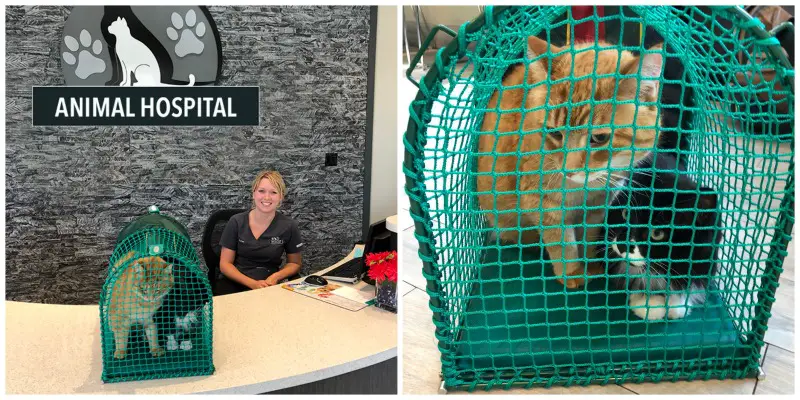
Photo: Our boys having just arrived at the vet’s office for their appointment
We all know how much Americans love their cats. In fact, approximately one third of households across the United States own at least one cat. Sadly, even with so many loving homes, many of these cats aren’t receiving the medical attention they need.
Research from Royal Canin found that 53 percent of cat owners who haven’t taken their cat to the vet in the last 12 months said they just “didn’t think it was necessary.”
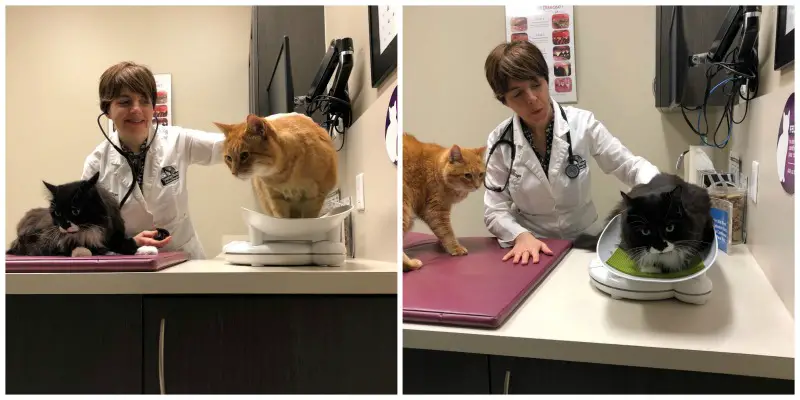
Photo: Our boys with their amazing (and long time) vet Dr. Barb
In order to improve the healthcare of cats in the United States, Royal Canin, a global leader in pet health nutrition is once again leading the charge for this year’s Take Your Cat to the Vet Day.
They partnered with actor and activist Ian Somerhalder and his cat, Moke, to raise awareness for their Take Your Cat To the Vet Day campaign to promote the importance of preventive veterinary care for cats.
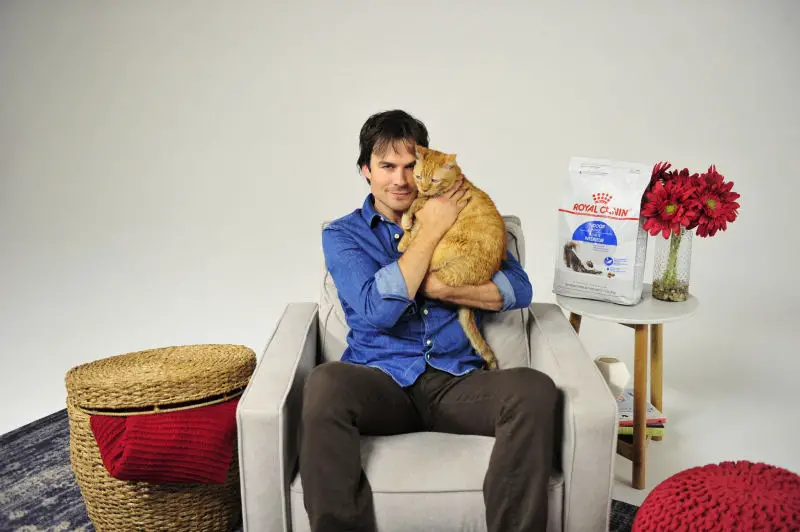
Photo by Michael Simon
“Cats are incredible animals. They teach us so many lessons about life, including how to care for something other than ourselves,” explained Ian Somerhalder, actor and owner of two cats and various other foster animals. “They rely on us. And we need to make their health a priority. That’s why I’m really passionate about Royal Canin’s Take Your Cat to the Vet Day initiative and hope more cat owners will schedule regular vet appointments for their cats.”
Also joining Somerhalder and Royal Canin to help raise awareness about the importance of preventive veterinary care are The American Association of Feline Practitioners, The International Cat Association, CATalyst Council and The Cat Fanciers’ Association.
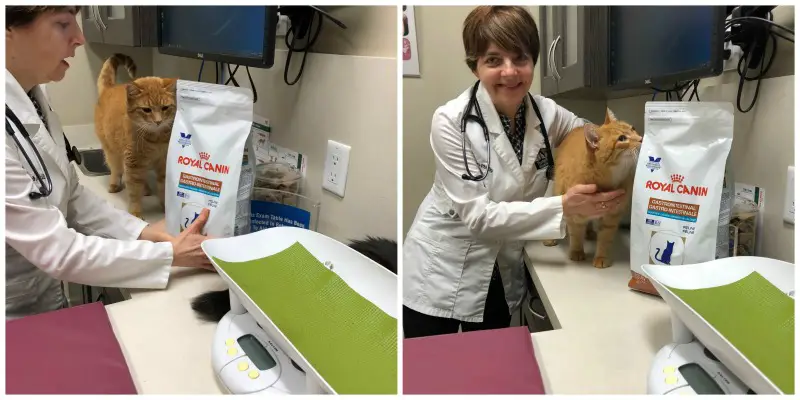
According to Royal Canin research, 21 percent of cat owners said they take their cat to the vet only after it’s already showing signs of illness. However, veterinary visits should not be limited to when your cat is in pain or battling an illness. In addition to vaccinations and routine checkups, it is critical to take cats to the vet regularly so that any health issues may be identified before they become more serious.
“Regular feline veterinary care is crucial for the health and happiness of your cat,” said Dr. Catherine Lenox, Royal Canin Scientific Affairs Manager and board-certified veterinary nutritionist. “Just like dogs, cats need to see the veterinarian on a regular basis for wellness exams, not only when there’s a serious medical need. Cat owners should identify a time throughout the year that can serve as a regular reminder for this important check-up – such as back to school or when they schedule their own annual medical appointment.”
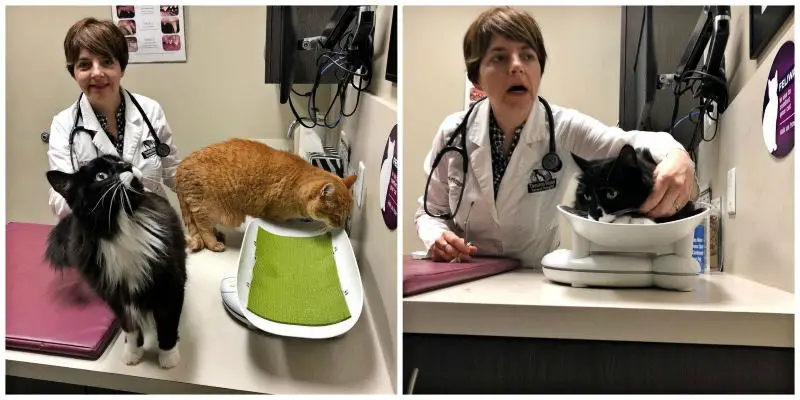
Cat owners avoid scheduling veterinary visits for many reasons, whether it be difficulty getting their cat to the vet or the belief that indoor cats aren’t as susceptible to illness or disease. Cats are also known to disguise their discomfort, which can allow health-related problems to go undetected by their owners.
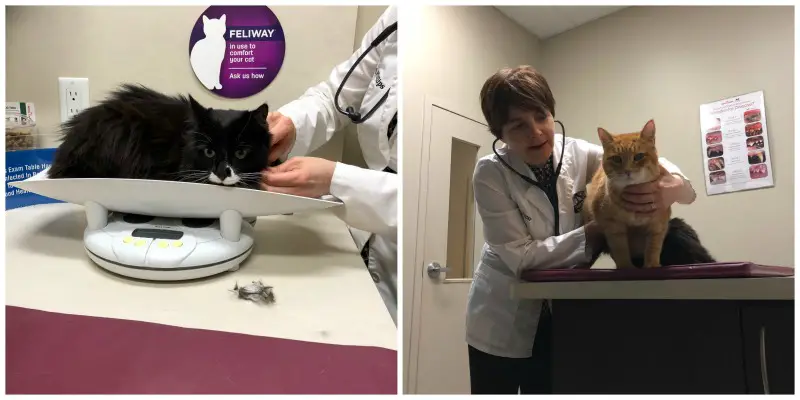
The veterinarian’s office can be unfamiliar and has sights, sounds and smells that can cause your cat to feel anxious or fearful. Cover their carrier with a towel to help block the sight of other animals and dampen the unfamiliar sounds. Respect your cat’s need for time to acclimate to the new environment. Ours always need a few minutes of exploratory time once in the room itself… usually in and around the sink and examination table.
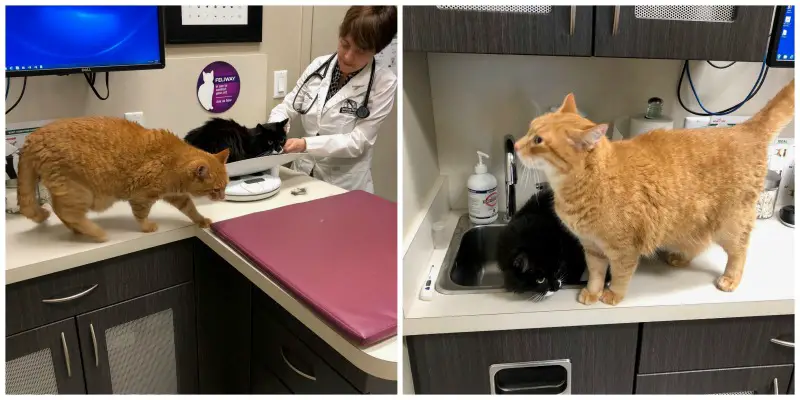
Remember that cats age more rapidly than humans. A cat reaches the approximate human age of 15 during its first year, and then 24 at age 2. Each year thereafter, they age approximately four “cat years” for every calendar year. So your 8-year-old cat would be 48 in cat years.
Veterinary care is crucial because a lot can happen in four “cat years,” which is why yearly visits are so important.
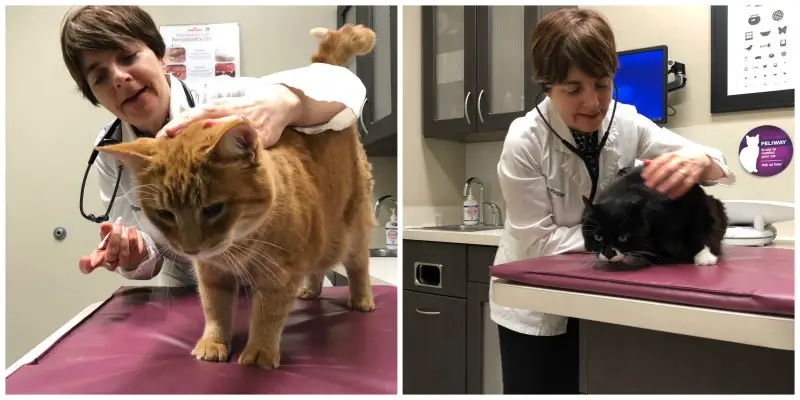
Cats are masters at hiding illness. Their natural behaviors make them excellent at hiding how they feel when they are sick or in pain. Your cat could be developing a health condition long before you notice anything is wrong. Veterinarians are trained to spot changes or abnormalities that could be overlooked and detect many problems before they advance or become more difficult to treat. 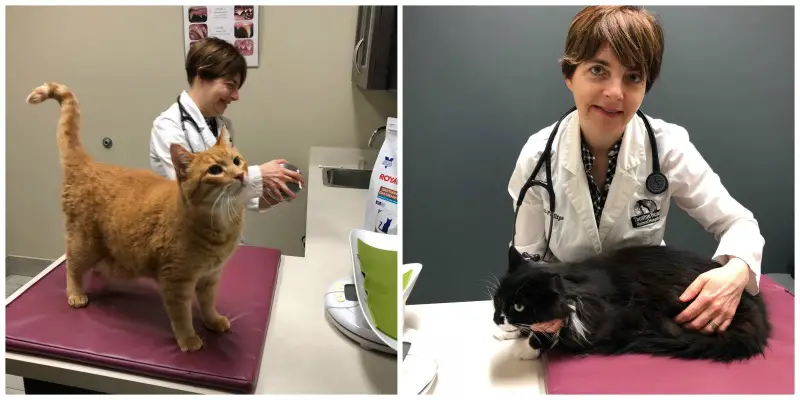
REGULAR CHECK-UPS ARE KEY TO A HEALTHY AND HAPPY CAT
We think that the following infographic nicely summarizes 5 reasons why routine vet visits need to be a vital part of your cat’s health regimen.
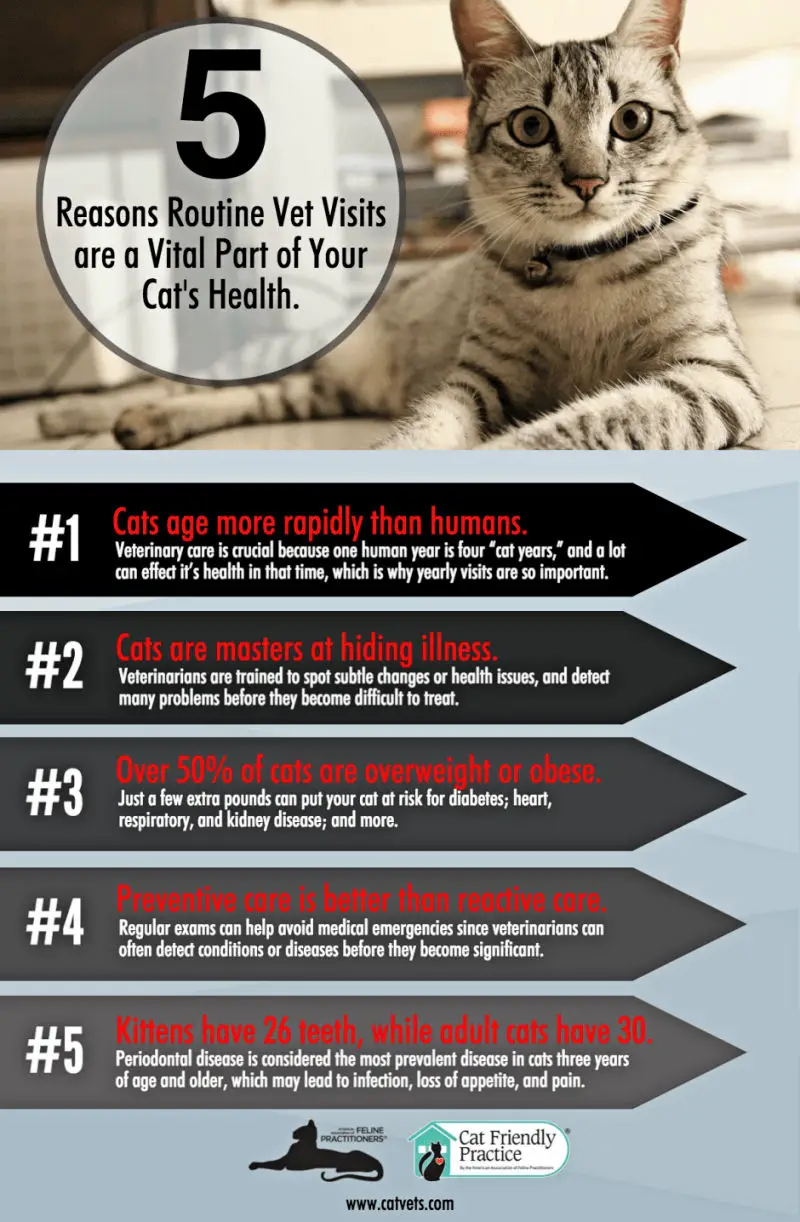
Credit: Infographic via AAFP
5 Ways to Make the Trip Less Stressful
According to the American Association of Feline Practitioners, there are several things cat owners can do to make visits to the veterinarian more stress-free:
1. Understand your cat’s behavior. The veterinarian’s office is unfamiliar and has sights, sounds and smells that can cause your cat to feel anxious or fearful. Cover their carrier with a towel to help block the sight of other animals and dampen the unfamiliar sounds. Respect your cat’s need for time to acclimate to the new environment.
2. Help your cat become comfortable with the carrier. Place the carrier in a room at home where your cat spends most of their time and equip it with familiar soft bedding as well as special toys.
3. Get the best carrier for your cat. Secure, stable, hard-sided carriers that open from the top and the front, and can also be taken apart in the middle, are best for your cat.
4. Take your cat to a Cat Friendly Practice®. These veterinary practices have made specific changes to decrease the stress and provide a more calming environment for you and your cat.
5. Keep peace in a multi-cat household. Leave the returning cat in the carrier for a few minutes to see how all of your cats react to unfamiliar smells, and separate if there are signs of tension.
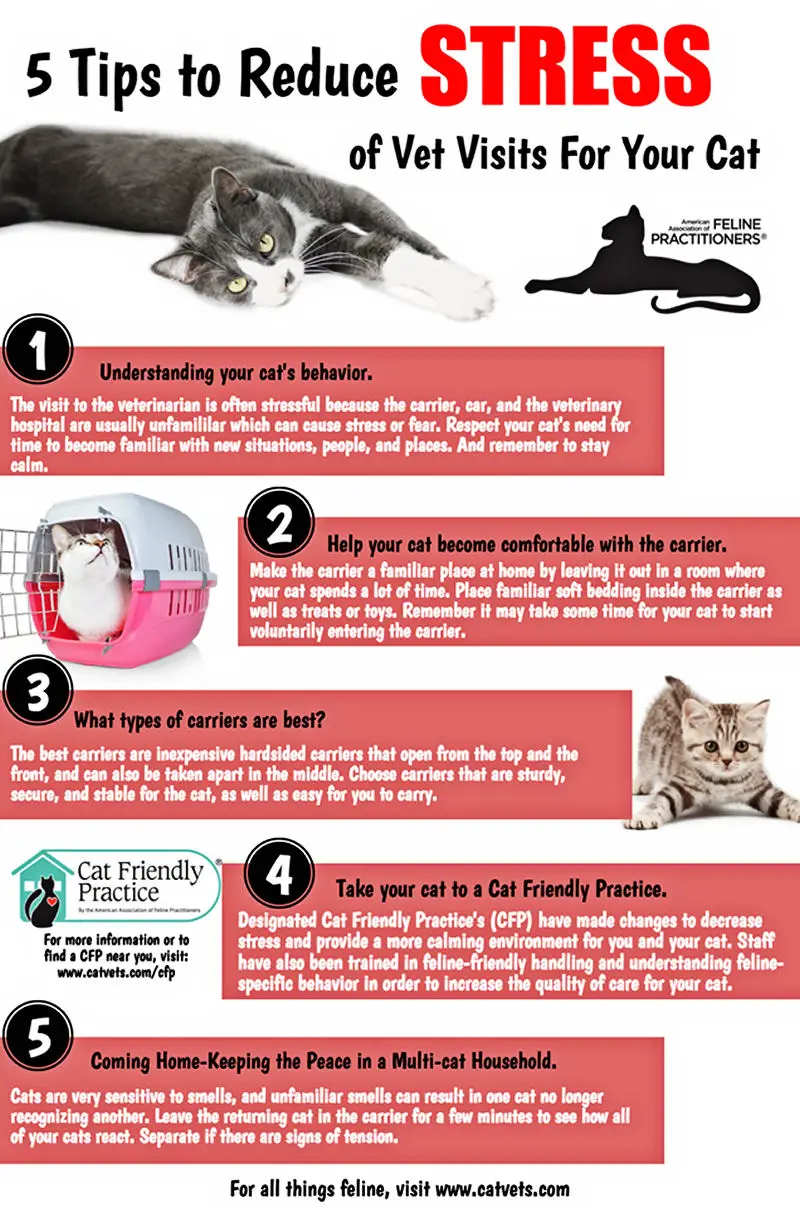
Credit: Infographic via AAFP
Summary & Disclosure
This post is sponsored by Royal Canin. While we are being compensated for helping spread the word about Royal Canin, The Purrington Post only shares information we feel is relevant to our readers. Royal Canin is not responsible for the content of this article. To learn more about Royal Canin, visit www.royalcanin.com or on Facebook at www.facebook.com/royalcanin.us.
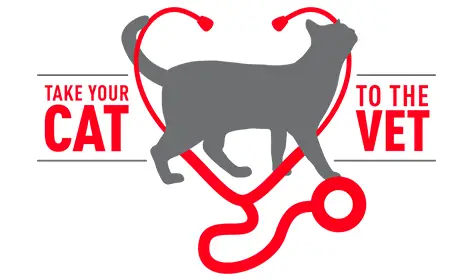
For more information and to locate a veterinarian near you or to learn more about Royal Canin’s Cat2VetDay campaign, please visit www.royalcanin.com/Cat2VetDay. You can also join the conversation on social media by using hashtag #Cat2VetDay.

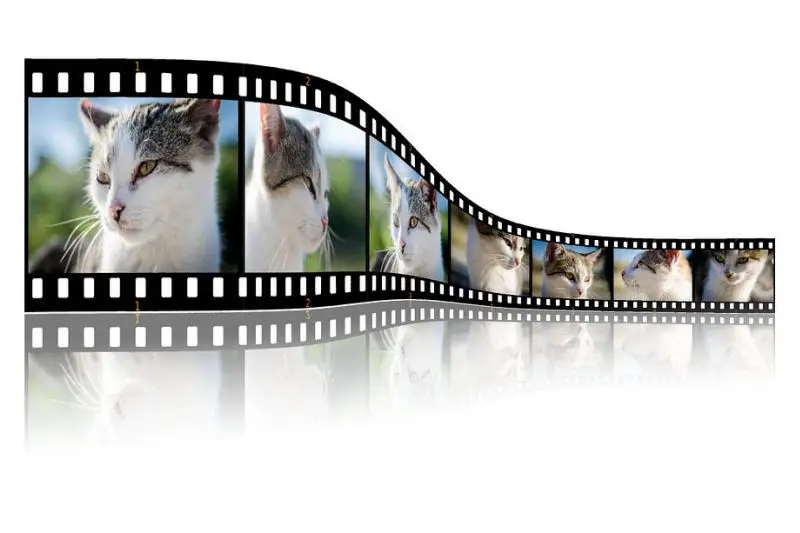



Especially great newsletter reminder (and wonderful pix of your handsome fur kids). In keeping with the “National Take Your Cat to the Vet Today,” Trinity and Groucho made their appearance at the vet clinic this morning. Given how ancient they both are, they’re doing very well. Big Dew Claw Up! (Already lost 4 so far in 2018.) Now the rest of the old dudes have to make their individual (or group) trips there as well. I sometimes think that it’s my feline horde that is making it possible for the clinic to do its current renovation. Can we hear a big “Meow”?
I just took our cat Chester to the vet today for his annual exam. He’s a senior cat, but the vet says he’s in great shape. I think that’s because Chester asks me to pull out one or more of his stash of favorite wand toys from the closet every day for some serious play time.
BTW, I have had our cats on Royal Canin dry food varieties for many, many years. They LOVE the flavor.
Great things as always. I do not get my time to take my cats to a vet. She is an outdoor cat. I should check her for same as this article is inspiring me to do. Thanks 🙂
Great article and love the inforgraphic
Love your Cats they look gorgeous
I appreciate you creating awareness.
I just took my Cat to the Vets yesterday. My Little furball (Tigger) had a broken tooth unfortunately and they took out 3.. Poor him
To be honest he was fine though, just the trip to the Vets he wants to get out of his Pet carrier and when he Meows, boy it goes straight to my heart and I want to let him out but I know it’s for his own benefit. He’s back home now and doing well..
I think it’s important to make sure our Cats are healthy as they are very good at hiding away any pain they’re feeling
Do you give your Cats any Vitamins? Which one would you recommend if you do?
I heard PetBounce MultiVitamin is good and there’s a review of this over at https://catloverhere.com/2018/08/31/best-vitamin-for-cats-why-your-cat-needs-vitamins-2018/
Would love to get your opinion on this.. Have you heard of it or given it to your Cat.. It looks good but would love a second opinion! Thanks!